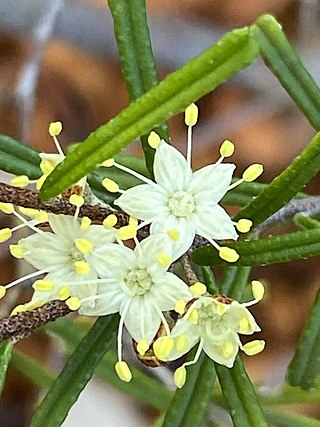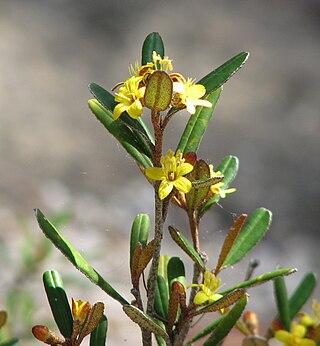
Phebalium daviesii, commonly known as St Helens wax flower or Davies' wax flower, is a species of shrub that is endemic to a restricted area in Tasmania. It is more or less covered with silvery or rust-coloured scales and has narrow wedge-shaped leaves with a notched tip, and umbels of white to cream-coloured, five-petalled flowers.

Phebalium whitei is a small shrub that is endemic to south-east Queensland. It has branchlets covered with silvery and rust-coloured scales, leathery, oblong to elliptic leaves and bright yellow flowers arranged in sessile umbels on the ends of branchlets.

Phebalium longifolium is a species of shrub that is endemic to far north Queensland. It is more or less covered with silvery to rust-coloured scales and has smooth branchlets, narrow elliptical to narrow lance-shaped leaves and cream-coloured flowers in umbels on the ends of branchlets. It grows in the boundary between forest and rainforest in tropical areas.
Philotheca apiculata is a species of flowering plant in the family Rutaceae and is endemic to the south-west of Western Australia. It is a small shrub with narrow club-shaped leaves and small clusters of white to pink flowers on the ends of branchlets.
Philotheca basistyla, commonly known as the white-flowered philotheca, is a species of flowering plant in the family Rutaceae and is endemic to the south-west of Western Australia. It is a small shrub with narrow club-shaped leaves and white flowers arranged singly on the ends of branchlets.
Philotheca citrina is a species of flowering plant in the family Rutaceae and is endemic to Western Australia. It is a much-branched shrub with curved, narrow club-shaped leaves and pale yellowish green flowers arranged singly on the ends of branchlets.

Philotheca coccinea is a species of flowering plant in the family Rutaceae and is endemic to Western Australia. It is a shrub with club-shaped leaves that are warty on the lower surface, and red to pink flowers arranged singly in leaf axils.
Philotheca cuticularis is a species of flowering plant in the family Rutaceae and is endemic to Queensland. It is a rounded shrub with small, crowded leaves and small white flowers arranged singly on the ends of branchlets.

Philotheca epilosa is a species of flowering plant in the family Rutaceae and is endemic to eastern Australia. It is a shrub with egg-shaped to lance-shaped leaves with the narrower end toward the base and crowded near the ends of the glandular-warty branchlets, and white flowers usually arranged singly on the ends of the branchlets.
Philotheca ericifolia is a species of flowering plant in the family Rutaceae and is endemic to New South Wales. It is a much-branched shrub with glandular-warty branchlets, needle-shaped leaves and white to pink flowers arranged singly or in groups of up to six on the ends of the branchlets.
Philotheca falcata, commonly known as the sickle-leaved waxflower, is a species of flowering plant in the family Rutaceae and is endemic to a small area in the south-west of Western Australia. It is a small, densely-branched shrub with narrow club-shaped leaves and single flowers on the ends of branchlets.

Philotheca gardneri is a species of flowering plant in the family Rutaceae and is endemic to the south-west of Western Australia. It is a shrub with crowded, narrow club-shaped or more or less spherical leaves and white flowers with a prominent pink midrib, usually borne singly on the ends of branchlets.
Philotheca glabra is a species of flowering plant in the family Rutaceae and is endemic to the inland south-west of Western Australia. It is a small shrub with elliptical to club-shaped leaves and white flowers tinged with pink and arranged singly or in twos or three on the ends of branchlets.

Philotheca glasshousiensis is a species of flowering plant in the family Rutaceae and is endemic to Queensland. It is a shrub with densely glandular-warty branchlets, lance-shaped to wedge-shaped leaves clustered near the ends of the branchlets and cream-coloured flowers arranged singly or in groups of up to five.
Philotheca kalbarriensis is a species of flowering plant in the family Rutaceae and is endemic to Western Australia. It is a shrub with reddish brown branchlets and crowded, narrow spindle-shaped leaves and single white flowers arranged in leaf axils.
Philotheca nutans is a species of flowering plant in the family Rutaceae and is endemic to the south-west of Western Australia. It is a small, densely-branched shrub with club-shaped to cylindrical, glandular-warty leaves and pendent, pale yellow to pale red flowers arranged singly in leaf axils.
Philotheca obovatifolia, commonly known as mountain wax-flower, is a species of flowering plant in the family Rutaceae and is endemic to eastern Australia. It is a small shrub with broadly egg-shaped leaves with the narrower end toward the base and densely crowded near the ends of the glandular-warty branchlets, and cream-coloured flowers tinged with pink and arranged singly or in groups of up to five in leaf axils.

Philotheca queenslandica is a species of flowering plant in the family Rutaceae and is endemic to south-eastern Queensland. It is a wiry shrub with elliptic to egg-shaped leaves with the narrower end toward the base and densely crowded near the ends of the glandular-warty branchlets, and cream-coloured flowers tinged with pink and arranged singly in leaf axils.

Philotheca sporadica, commonly known as Kogan waxflower, is a species of flowering plant in the family Rutaceae and is endemic to south-eastern Queensland. It is a shrub with small, narrow oval leaves with the narrower end toward the base and white flowers with a pink midrib, usually arranged singly on the ends of branchlets.
Philotheca wonganensis, commonly known as Wongan philotheca, is a species of flowering plant in the family Rutaceae and is endemic to the south-west of Western Australia. It is a shrub with thin, cylindrical leaves and white flowers with a pink central stripe, usually arranged singly in leaf axils.








